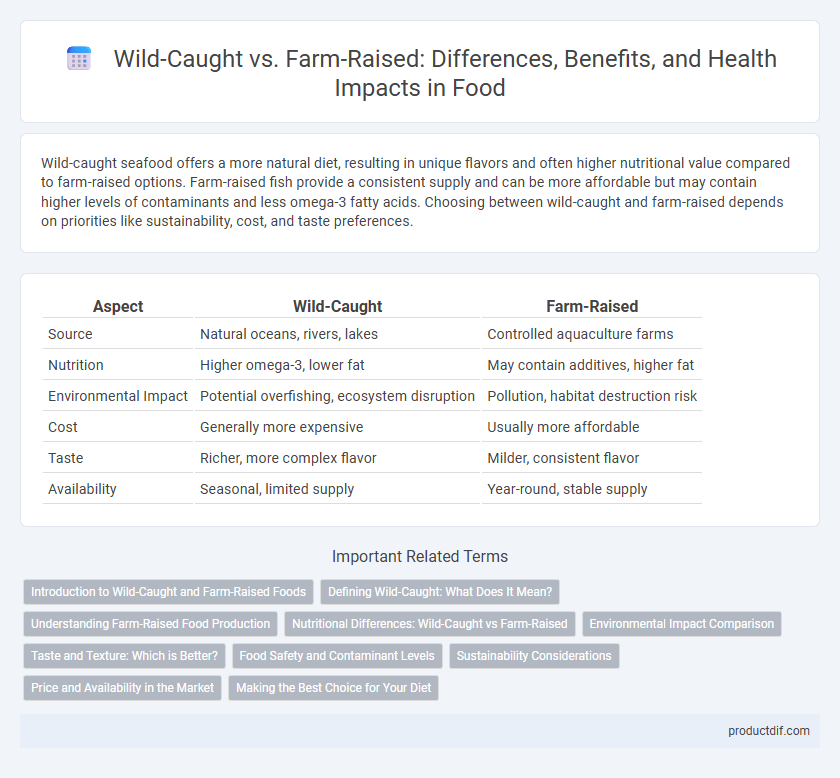Wild-caught seafood offers a more natural diet, resulting in unique flavors and often higher nutritional value compared to farm-raised options. Farm-raised fish provide a consistent supply and can be more affordable but may contain higher levels of contaminants and less omega-3 fatty acids. Choosing between wild-caught and farm-raised depends on priorities like sustainability, cost, and taste preferences.
Table of Comparison
| Aspect | Wild-Caught | Farm-Raised |
|---|---|---|
| Source | Natural oceans, rivers, lakes | Controlled aquaculture farms |
| Nutrition | Higher omega-3, lower fat | May contain additives, higher fat |
| Environmental Impact | Potential overfishing, ecosystem disruption | Pollution, habitat destruction risk |
| Cost | Generally more expensive | Usually more affordable |
| Taste | Richer, more complex flavor | Milder, consistent flavor |
| Availability | Seasonal, limited supply | Year-round, stable supply |
Introduction to Wild-Caught and Farm-Raised Foods
Wild-caught foods, sourced directly from natural habitats like oceans and rivers, typically offer higher levels of omega-3 fatty acids and fewer contaminants compared to farm-raised alternatives. Farm-raised foods are cultivated in controlled environments, enabling consistent supply and reduced pressure on wild populations but may involve the use of antibiotics and feed additives. The choice between wild-caught and farm-raised often hinges on factors such as environmental sustainability, nutritional content, and food safety.
Defining Wild-Caught: What Does It Mean?
Wild-caught seafood refers to fish and shellfish harvested directly from their natural habitats, such as oceans, rivers, and lakes, without human intervention in their breeding or growth. This method typically results in seafood that reflects its natural diet, environment, and seasonal variations, influencing flavor and nutritional content. Wild-caught species often exhibit higher levels of omega-3 fatty acids, lower contaminants, and more diverse ecological benefits compared to farm-raised alternatives.
Understanding Farm-Raised Food Production
Farm-raised food production involves controlled environments where seafood and livestock are bred for consistency and efficiency. This method relies on regulated feed, water quality management, and disease control to maximize yield and reduce environmental impact. Understanding these practices helps consumers evaluate the sustainability and nutritional differences compared to wild-caught alternatives.
Nutritional Differences: Wild-Caught vs Farm-Raised
Wild-caught seafood typically contains higher levels of omega-3 fatty acids, vitamin D, and antioxidants compared to farm-raised counterparts due to their natural diet and active environment. Farm-raised fish often have increased fat content, including omega-6 fatty acids, which may contribute to an imbalanced nutrient profile. The nutritional differences impact heart health, inflammation, and overall diet quality, making wild-caught options generally more beneficial for nutrient density.
Environmental Impact Comparison
Wild-caught seafood typically has a lower carbon footprint due to the absence of feed production and minimal intervention in natural habitats, though it can lead to overfishing and ecosystem disruption if unmanaged. Farm-raised fish reduce pressure on wild populations but often require intensive resource inputs such as fishmeal, antibiotics, and energy, contributing to water pollution and habitat degradation. Sustainable practices in both methods are crucial for minimizing environmental impact and preserving marine biodiversity.
Taste and Texture: Which is Better?
Wild-caught seafood typically offers a firmer texture and more complex, robust flavors due to its natural diet and active lifestyle, appealing to gourmets seeking authenticity. Farm-raised varieties often present a milder taste with a softer, more consistent texture, influenced by controlled feeding and environment. Taste preferences vary, but culinary experts often favor wild-caught for its distinct sensory qualities linked to natural habitats.
Food Safety and Contaminant Levels
Wild-caught seafood generally exhibits lower levels of contaminants like antibiotics and pesticides compared to farm-raised varieties, which can be exposed to higher risks of chemical residues due to feed and water conditions. Food safety concerns in farm-raised fish often include the presence of pathogens and harmful bacteria stemming from overcrowded environments, whereas wild-caught fish benefit from more natural habitats that reduce these risks. Monitoring programs by agencies such as the FDA and NOAA emphasize testing contaminant levels to ensure consumer protection for both wild-caught and farm-raised seafood.
Sustainability Considerations
Wild-caught seafood harvesting impacts marine ecosystems through overfishing and habitat disruption, raising concerns about long-term sustainability. Farm-raised fish reduce pressure on wild populations but can contribute to water pollution and disease spread if not managed responsibly. Sustainable practices in both methods prioritize eco-friendly techniques, such as selective harvesting and improved aquaculture systems, to balance environmental health and food security.
Price and Availability in the Market
Wild-caught seafood generally commands higher prices due to limited supply and seasonal variability, making it less consistently available in the market. Farm-raised options offer more stable pricing and year-round availability, benefiting from controlled breeding and harvesting environments. Consumers often weigh cost-effectiveness and accessibility when choosing between wild-caught and farm-raised seafood products.
Making the Best Choice for Your Diet
Choosing between wild-caught and farm-raised seafood depends on nutritional content, environmental impact, and potential contaminants. Wild-caught fish often provide higher levels of omega-3 fatty acids and fewer additives, while farm-raised options can be more affordable and sustainably managed if sourced responsibly. Evaluating factors such as mercury levels, habitat preservation, and dietary needs helps make the best choice for a healthy, balanced diet.
Wild-Caught vs Farm-Raised Infographic

 productdif.com
productdif.com